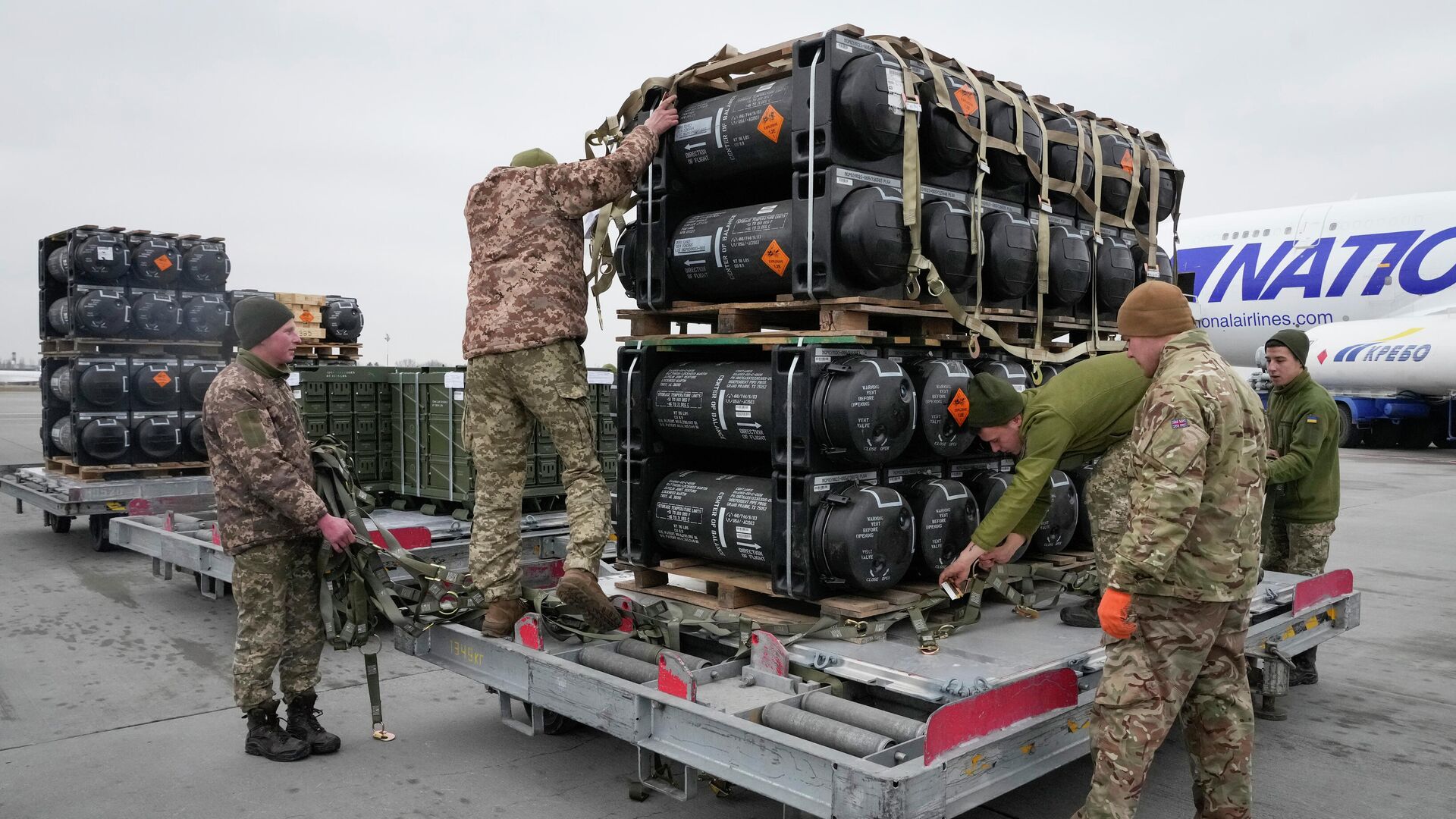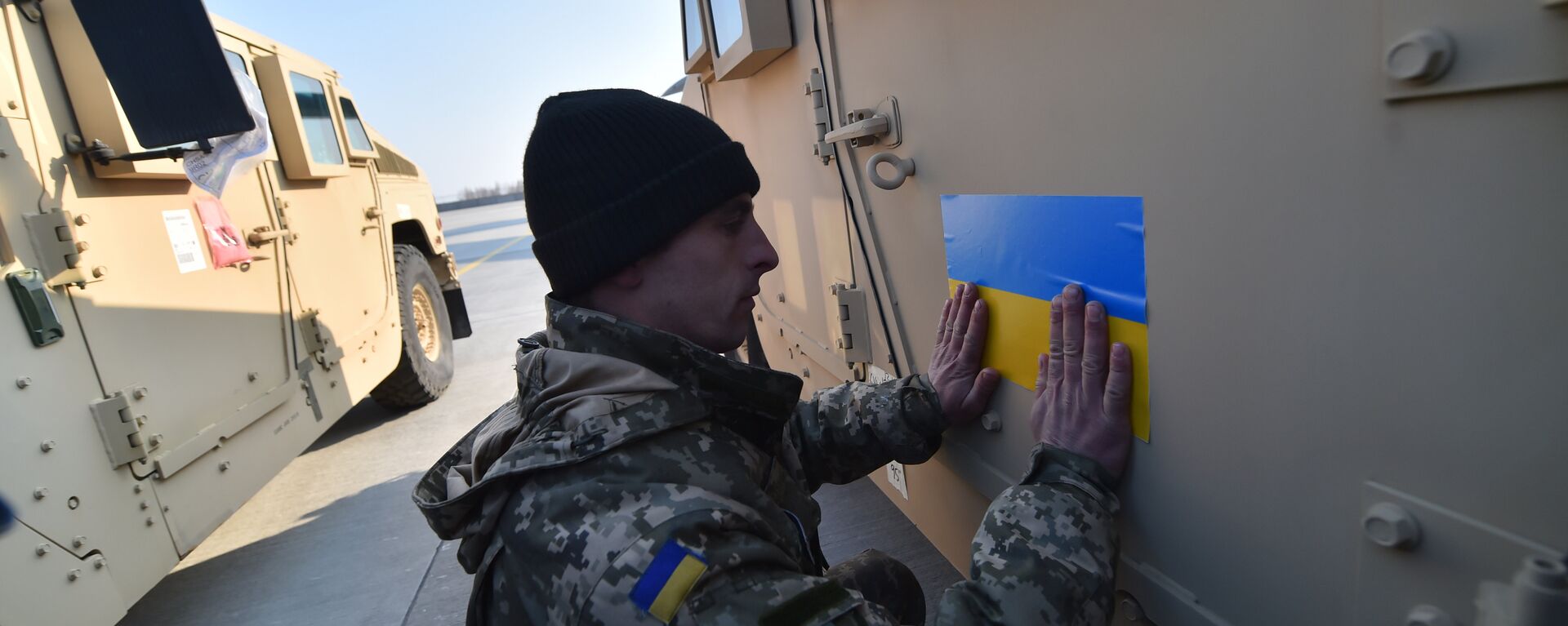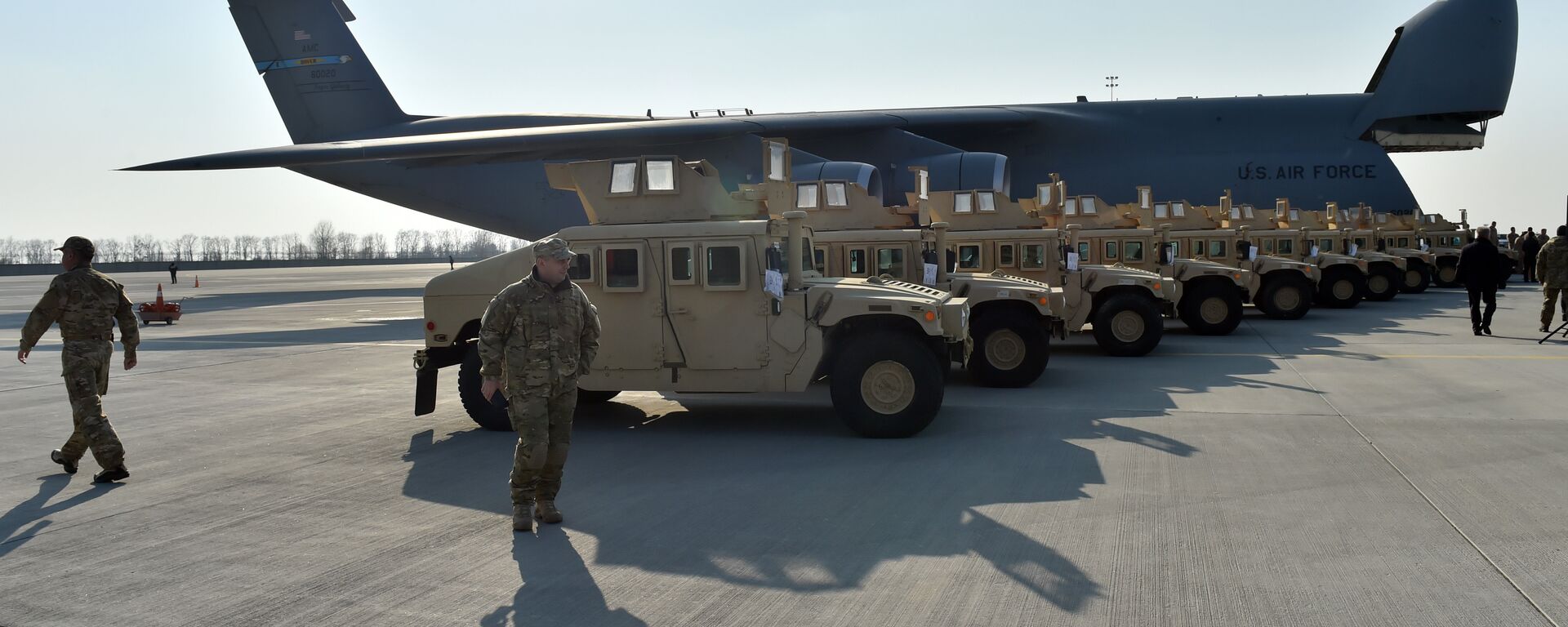https://sputnikglobe.com/20220415/us-allies-face-depleted-weapons-stockpiles-as-aid-to-kiev-blows-through-supplies-report-1094789761.html
US, Allies Face Depleted Weapons Stockpiles As 'Aid' to Kiev 'Blows Through' Supplies: Report
US, Allies Face Depleted Weapons Stockpiles As 'Aid' to Kiev 'Blows Through' Supplies: Report
Sputnik International
Thousands of Javelin anti-tank weapon systems, Stinger anti-aircraft systems, and other lethal weapons have already been given to Ukraine by Washington, with... 15.04.2022, Sputnik International
2022-04-15T13:32+0000
2022-04-15T13:32+0000
2023-04-13T12:44+0000
russia's special operation in ukraine
russia
javelin
stinger missiles
ukraine
us
pentagon
https://cdn1.img.sputnikglobe.com/img/07e6/03/01/1093482779_0:0:3277:1844_1920x0_80_0_0_b611052748eef8398e4f9e09cea112d4.jpg
Amid the ongoing Russian special operation to "demilitarise and de-Nazify" Ukraine, Western countries are facing a stark choice between continuing to send weapons to Kiev’s forces or shoring up their own depleted defences, reported Bloomberg.The Pentagon has reportedly warned that Kiev has been “blowing through” a week’s worth of deliveries of antitank munitions daily, while also facing shortfalls of usable aircraft as Russia continues its special operation reported the outlet.Moscow’s airstrikes and Ukraine’s combat losses have been taking their toll, with Kiev’s forces ostensibly running low on ammunition. However, the US has already supposedly provided one-third of its overall stockpile of Javelin anti-tank missiles to in response to President Volodymyr Zelensky’s pleas. If the US were to deliver any more, it would risk leaving its own armouries badly depleted, stated the report. It might require months, maybe even years to significantly ramp up production.‘Arsenal of Democracy’America has been following an “arsenal of democracy” strategy, entailing avoiding direct intervention in the crisis in Ukraine, according to the report. This approach has entailed pressing NATO allies and partners to funnel weapons and funds to the Ukrainian government, in a strategy dating back to WWII.US President Franklin D. Roosevelt used the phrase “great arsenal of democracy” on 29 December 1940, when he promised to help the United Kingdom fight Nazi Germany by selling them military supplies, while Washington dodged any actual fighting.Now, as Russia is redeploying soldiers to Ukraine's south and east, Ukraine is issuing increasingly vocal demands for more armaments from the West.However, Kiev's pleas come as the “arsenal of democracy” is reportedly being depleted, laying bare American “weaknesses”.The US and its allies have sent drones, antitank and anti-aircraft weapons, ammunition and other capabilities to Kiev. Congress heard from General Mark Milley, the chairman of the US Joint Chiefs of Staff, that the Western countries had delivered 60,000 antitank weapons and 25,000 anti-aircraft weapons to prop up Ukraine’s armed forces, which have been pummelled by Russia’s troops.On Wednesday, the Pentagon revealed it was planning to send a new $800 million package of arms supplies, including additional artillery, coastal defence drones, helicopters and armoured personnel carriers.However, the report claims that Joe Biden’s administration had not planned for being forced to support a protracted high-intensity conventional fight that entails such intense attrition of munitions and military assets.Washington’s allies had been quick to vocally denounce Russia’s operation, begun on 24 February in response to a request for assistance from the Donetsk and Lugansk People’s Republics (DPR and LPR), which had been subjected to escalating attacks by Kiev authorities.According to the Russian Defence Ministry, the operation only targets Ukraine's military infrastructure with high-precision weapons. However, the US, its NATO allies have approved sending "new and heavier" weapons to Ukraine. The European Union also approved the disbursement of a €500 million (£416 million) loan to Ukraine to fund more arms.Moscow has repeatedly warned that NATO arms supplies to Kiev were only exacerbating the Ukrainian conflict and could lead to greater loss of life.Now, as General Mark Milley insisted that a standoff in the “south-east, down around the Donbass, Donetsk region western Ukraine” would be crucial to the outcome of the crisis, Germany has declined to transfer tanks to Ukraine. Berlin argues that that it simply cannot spare them.Canada had also ostensibly been running short on rocket launchers and other equipment demanded by the Ukrainian side.Accordingly, the Ukraine crisis has offered sobering insight into the problems the US itself would face in the event of a conflict against Russia or China, claims the report.Washington would likely face “missile famine,” spending its stockpiles of projectiles, precision-guided munitions and other critical capabilities in days or weeks, while potentially suffering severe losses of tanks, planes, ships and other sophisticated and costly military assets.Replenishing the military arsenal might turn out to be quite a daunting challenge, claims the report, as shortages of machine tools, skilled labour and spare production capacity could slow a rearmament effort down.As an example, the report cites the impossibility of quickly scaling up production of Stinger missiles for Ukraine due to absence of an available workforce for this.The Ukraine conflict, underscored the report, has typically previewed what it might take to ensure that the much-touted “arsenal of democracy” is equal to its ambitious tasks.
https://sputnikglobe.com/20220414/us-to-provide-ukraine-with-even-more-intel-heavier-equipment-in-near-future---report-1094745739.html
https://sputnikglobe.com/20220413/new-us-military-aid-package-to-ukraine-may-include-humvee-armored-vehicles-reports-suggest-1094728489.html
https://sputnikglobe.com/20220415/russia-warns-us-against-irresponsible-arms-supplies-to-ukraine-in-diplomatic-note---media-1094788351.html
ukraine
Sputnik International
feedback@sputniknews.com
+74956456601
MIA „Rossiya Segodnya“
2022
News
en_EN
Sputnik International
feedback@sputniknews.com
+74956456601
MIA „Rossiya Segodnya“
Sputnik International
feedback@sputniknews.com
+74956456601
MIA „Rossiya Segodnya“
javelin, stinger missiles, ukraine, us, pentagon
javelin, stinger missiles, ukraine, us, pentagon
US, Allies Face Depleted Weapons Stockpiles As 'Aid' to Kiev 'Blows Through' Supplies: Report
13:32 GMT 15.04.2022 (Updated: 12:44 GMT 13.04.2023) Thousands of Javelin anti-tank weapon systems, Stinger anti-aircraft systems, and other lethal weapons have already been given to Ukraine by Washington, with the White House announcing on 13 April that it will send $800 million in additional weapons to Kiev, including artillery, armored personnel carriers, and helicopters.
Amid the ongoing Russian
special operation to "demilitarise and de-Nazify" Ukraine, Western countries are facing a stark choice between continuing to send weapons to Kiev’s forces or shoring up their own depleted defences, reported Bloomberg.
The Pentagon has reportedly warned that Kiev has been “blowing through” a week’s worth of deliveries of antitank munitions daily, while also facing shortfalls of usable aircraft as Russia continues its special operation reported the outlet.
Moscow’s airstrikes and Ukraine’s combat losses have been taking their toll, with Kiev’s forces ostensibly running low on ammunition. However, the US has already supposedly provided one-third of its overall stockpile of Javelin anti-tank missiles to in response to President Volodymyr Zelensky’s pleas. If the US were to deliver any more, it would risk leaving its own armouries badly depleted, stated the report. It might require months, maybe even years to significantly ramp up production.
America has been following an “arsenal of democracy” strategy, entailing avoiding direct intervention in the crisis in Ukraine, according to the report. This approach has entailed pressing NATO allies and partners to funnel weapons and funds to the Ukrainian government, in a strategy dating back to WWII.
US President Franklin D. Roosevelt used the phrase “great arsenal of democracy” on 29 December 1940, when he promised to help the United Kingdom fight Nazi Germany by selling them military supplies, while Washington dodged any actual fighting.
Now, as Russia is redeploying soldiers to Ukraine's south and east, Ukraine is issuing increasingly vocal demands for more armaments from the West.
However, Kiev's pleas come as the “arsenal of democracy” is reportedly being depleted, laying bare American “weaknesses”.
The US and its allies have sent drones, antitank and anti-aircraft weapons, ammunition and other capabilities to Kiev. Congress heard from General Mark Milley, the chairman of the US Joint Chiefs of Staff, that the Western countries had delivered 60,000 antitank weapons and 25,000 anti-aircraft weapons to prop up Ukraine’s armed forces, which have been pummelled by Russia’s troops.
On Wednesday, the Pentagon revealed it was planning to send a new $800 million package of arms supplies, including additional artillery, coastal defence drones, helicopters and armoured personnel carriers.
However, the report claims that Joe Biden’s administration had not planned for being forced to support a protracted high-intensity conventional fight that entails such intense attrition of munitions and military assets.
Washington’s allies had been quick to vocally denounce Russia’s operation, begun on 24 February in response to a request for assistance from the Donetsk and Lugansk People’s Republics (DPR and LPR), which had been subjected to escalating attacks by Kiev authorities.
According to the Russian Defence Ministry, the operation only targets Ukraine's military infrastructure with high-precision weapons.
However, the US, its NATO allies have approved sending "new and heavier" weapons to Ukraine. The European Union also approved the disbursement of a €500 million (£416 million) loan to Ukraine to fund more arms.
Moscow has repeatedly warned that NATO arms supplies to Kiev were only exacerbating the Ukrainian conflict and could lead to greater loss of life.
Now, as General Mark Milley insisted that a standoff in the “south-east, down around the Donbass, Donetsk region western Ukraine” would be crucial to the outcome of the crisis, Germany has declined to transfer tanks to Ukraine. Berlin argues that that it simply cannot spare them.
Canada had also ostensibly been running short on rocket launchers and other equipment demanded by the Ukrainian side.
Accordingly, the Ukraine crisis has offered sobering insight into the problems the US itself would face in the event of a conflict against Russia or China, claims the report.
Washington would likely face “missile famine,” spending its stockpiles of projectiles, precision-guided munitions and other critical capabilities in days or weeks, while potentially suffering severe losses of tanks, planes, ships and other sophisticated and costly military assets.
Replenishing the military arsenal might turn out to be quite a daunting challenge, claims the report, as shortages of machine tools, skilled labour and spare production capacity could slow a rearmament effort down.
As an example, the report cites the impossibility of quickly scaling up production of Stinger missiles
for Ukraine due to absence of an available workforce for this.
The Ukraine conflict, underscored the report, has typically previewed what it might take to ensure that the much-touted “arsenal of democracy” is equal to its ambitious tasks.





